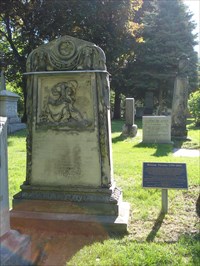
William Thomas (1799 - 1860)
This monument was designed by William Thomas, one of the most important
architects in Victorian Canada, and made by Cochrane Brothers, Toronto's leading stone
carvers in the mid-19th century. Thomas emigrated from England in 1843 and was responsible
for such notable landmarks as St. Lawrence Hall, St. Michael's Cathedral and the
Don Jail in this city. His many other Canadian works include Brock's Monument at Queenston,
as well as churches and public buildings in Guelph, Halifax, Hamilton, London,
Niagara-on-the-Lake and Quebec City. Thomas was founding president of the
Association of Architects, Civil Engineers and Provincial Land Surveyors,
the earliest professional body in Canada.
When the inscription on the stone was legible, it recorded the burials of three of William Thomas's children:
Ada Thomas died July 8 1846 aged 2 months and 7 days,
Albert Thomas born at Birmingham, England died October 30 1849 aged 17 years,
Martha Thomas born at Royal Leamington Spa England died August 14 1850 aged 14 years.
Thomas, his wife Martha and another child were buried here too, though the inscription did not mention them:
William Thomas
born Nacton, Suffolk, England, June 6 1799 died Toronto, December 26 1860,
Martha Tutin
died Chicago, March 6, 1874 aged 72 years and
Helena Thomas
born Royal Leamington Spa, England, 1840 died Guelph, November 21, 1916.

From: The Canadian Encyclopedia
William Thomas
William Thomas, architect, engineer, surveyor (b in Suffolk, England 1799; d at Toronto 26 December 1860). One of the founders of the Canadian architectural profession, William Thomas's work in England would have ensured him a modest place in English architectural history. It was, however, for his mark on the fledgling communities of central and eastern Canada for which he is best remembered. From 1843 to 1860, his ouput in Canada included over 100 buildings, including some of the finest architectural specimens of mid-19th-century Toronto as well as a legacy of work spread throughout the province and country.
Thomas moved to Birmingham in 1819 to work for Richard Tutin, a builder and surveyor. He married Martha Tutin in 1826 and joined the firm as architect-partner until Tutin's death in 1832, when he opened his own practice in nearby Leamington Spa. The elegant late-Georgian speculative housing projects he entered into there would eventually lead to his bankruptcy in 1840. After executing further commissions in Birmingham, Thomas set sail with his wife and 8 children for Toronto in 1843.
A leading ecclesiastical architect and the chief proponent of Gothic Revival in Canada, Thomas's churches include St Paul's Church, London (1844), St Michael's Cathedral and Bishops Palace, Toronto (1845-48), St Paul's Church, Hamilton (1854) and St Matthew's Church, Halifax (1857).
A lover of sculptural detail, Thomas's residential work, including his own Oakham House, Toronto (1848) and Inglewood House, Hamilton (1852), displays a florid array of stone-carved details. In this regard, the pinnacle of his career was the Brock Monument, Queenston (1852-59) with its fine quality of sculptural decoration; upon completion it was the second largest monument of its kind in the world.
Today Thomas is best known for his commercial and institutional buildings, which include the Commercial Bank of the Midland District, Toronto (1844), (whose reconstructed facade is now part of the BCE Place), the ST LAWRENCE HALL and Market, Toronto (1845-50), courthouses of Niagara and Kent Districts (1846-47), Guelph Town Hall (1856), Québec Custom House and Halifax Courthouse (1858), and the infamous Don Jail, Toronto (1857-64).
A founder and president (until his death in 1860) of Canada's first professional association of architects, engineers and surveyors, Thomas's legacy includes the first indigenously trained architects in the province: William Storm (1826-99) and his 2 sons William Tutin (1829-92) and Cyrus Thomas (1838-1911).